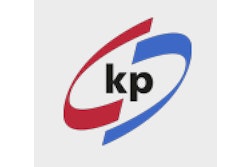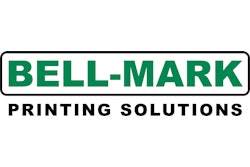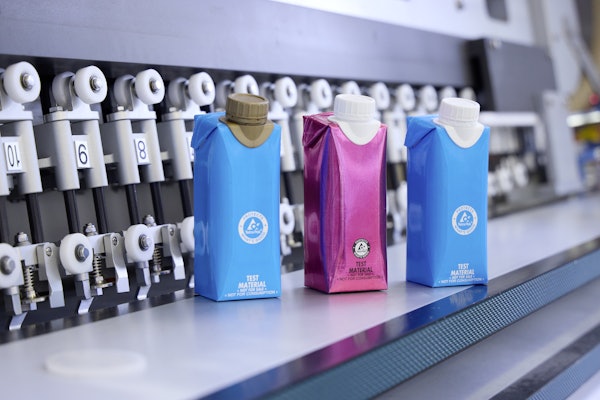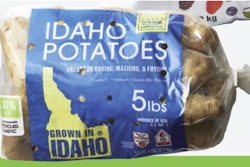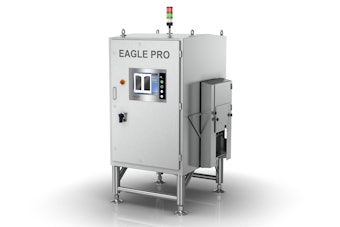While most of this year's winners in the Flexible Packaging Assn.'s annual awards competition fall neatly into either food or medical/surgical categories (see p. 30 and p. 60), three of the winners are uniquely uncategorizable. For instance, how about the Celebration Cup (1), a unit-dose package for Holy Communion containing wine and a wafer in separate compartments?
Chicago-based Compak Intl. markets this unique product, which was introduced last year and has been adopted by several religious groups. Benefits include quicker distribution for large congregations. The disposable package is also cleaner and more hygienic. With colds and other illnesses so easy to transmit, the Celebration Cup addresses concerns about hygiene without altering a traditional component of religious services.
"I think the product has done very well in the close-knit church community," says George Pleshar of Compak. It's being considered for use by the U.S. military, as well as some groups in South America.
The cups, made from 25-mil food-grade Pentafood® 757 polyvinyl chloride from Klockner Pentaplast (Gordonsville, VA), are made 30-up on a "one-of-a-kind" thermo- form/fill/seal machine from Klockner Medipak (Clearwater, FL). It employs a patented "two-lid system." First, cups are formed to a depth of approximately 1" and filled with 5 mL of grape juice. The primary lid, a foil lidstock from Hueck Foils (Manasquan NJ), is then heat-sealed to the flange. The communion wafer is placed on top of the lidding film and a secondary lid, a 12-micron polyester film, also from Hueck Foils, is sealed on top. This film is gravure-printed. The cups are made and filled at speeds up to 900/min by contract packager Olmarc (Franklin Park, IL).
Sold directly to churches or through distributors, the Celebration Cup is available in 500-, 210- and 60-count boxes. Shelf life is about six months.
A pair of pouches
The other two FPA winners in this group are both stand-up pouches with recloseable zippers. But they serve very different industries.
First there's the nozzled pouches for 3M's FastBond(TM) 2000 (2). Since late 1995, these innovative packages have opened doors for small end-users in the cabinet making, furniture, woodworking and upholstery industries.
The two-component water-based adhesive is a state-of-the-art alternative to solvent-based adhesives. At first it was only available in 55-gal drums and 5-gal pails. Before long, St. Paul-based 3M realized that its packaging options were excluding small end-users, because those operations weren't able to use the large quantities of adhesive.
The 1-liter stand-up pouch format, in combination with a newly developed pressurized spraying system, addresses this problem head-on. Users attach the nozzles of two pouches-one containing an adhesive and the other an activator-to the spraying system, which dispenses the components in the appropriate ratio. Should an application not require the contents of an entire pouch, the threaded cap allows storage and reuse.
The gusseted bottom of the pouch allows it to sit upright, making it easy to transport in a special "caddy box" provided by 3M. Since the flexible bag collapses on itself, the need for air bleed nozzles, which could potentially result in leakage, is eliminated. Moreover, the package employs a resealable zipper that serves two purposes. First, it acts as a pressure-relief safety mechanism in case internal pressure builds too high during dispensing. Second, for customers who buy the adhesive product in bulk pails or drums and have purchased the portable FastBond 2000 system for use in temporary or remote locations, the pouch can be refilled through the zipper opening.
The pouch also has environmental advantages, as it weighs about 33% less than traditional pails, says manufacturer Kapak (Minneapolis, MN). And because it collapses fully when empty, it occupies far less landfill space.
In making the pouch, Kapak first reverse-prints a 48-ga polyester. Then it laminates the polyester to 100-ga biaxially oriented nylon and 6-mil linear low-density polyethylene, using a proprietary adhesive that prevents pouches from bursting or delaminating during shipping or dispensing. The reclosable zipper is applied to the three-layer rollstock. Pouches are then formed, and high-density polyethylene pour spouts are applied off-line. A clear "window" in the pouch allows users to identify each of three different adhesive types by color.
Preformed pouches are filled through the top and then heat-sealed on-site at 3M. The system is shipped by distributors to small end-users in cases holding 11 pouches of adhesive and one pouch of activator.
"It's doing well so far," says Chuck Stobbie, market development manager at 3M. "We think it has a bright future."
Improving the 'vault'
At about the same time that Packaging World reported on DowElanco's use of an unusual flexible package for its Dursban 50W insecticide (see PW, Nov. '94, p. 38), the company was already involved with looking for improvements. Although that first package later won an FPA award, what appears to be a modest improvement caused the judges to honor it again (3).
The improvement-a replacement of the zipper lock with a patented relockable device-is virtually the only change to the package. While it seems a minor change to the complete package, the new zipper lock not only maintained the product's Child-Resistant status, it also passed Consumer Product Safety Commission protocol testing for being senior friendly.
The Indianapolis-based manufacturer still markets seven pouches made of water-soluble polyvinyl alcohol inside a large pouch. It's a tough lamination of reverse-printed 48-ga polyester that's adhesively mounted to 0.00035 aluminum foil and eventually laminated to 3 mils of Valeron®, a tough, cross-laminated film of high-density PE from Valéron Strength Films (Houston, TX) with an interior heat-seal coating. This material is supplied by Georgia Packaging (Columbus, GA); the company had been known as Bell Flexible Packaging two years ago.
The rollstock is sent to Pactech (Rochester, NY) where it's fabricated into folded two-side-sealed bags that incorporate a zipper opening device from MiniGrip (Manteno, IL). The open-bottom bags are manually loaded by DowElanco and a contract packager, heat-sealed closed, and a large informational booklet is applied to the back of each pouch. Just like the first version, Packtech calls the package CRREO(TM), for child-resistant reclosable easy open.
Until early last year, the zipper lock was provided by a plastic tie-wrap. Now an injection molder, Convey, Inc. (Euless, TX), molds from polypropylene a part that Pactech sonically welds to the zipper tab and bag. Instructions for releasing the zipper tab are now printed just above the zipper on the front of the bag.
Injection-molded lock
"The new lock operates like scissors with a natural memory to it," says Pactech president Dave Diederich. "When the zipper tab is properly seated into this closure, the zipper is locked. When you squeeze together the two ends, you can release the zipper and open the bag. When the lock is reseated, the zipper relocks." Diederich, along with Ray and Tim Brooks of Convey, jointly applied for a patent on the device.
Ray Brooks' son Tim is responsible for the part design, based on input from Ray and from Diederich. Ray then designed a unit mold that was modified several times to achieve the final part. As samples were produced, Diederich worked with testing lab Walker Information Services (Indianapolis, IN) to check on the device's ability to remain child-resistant and to achieve senior-friendly status. Several modifications were made along the way. "We had to keep modifying the mold as we responded to the protocol testing," Ray Brooks recalls. When the tests verified both CR and SF, Convey built production molds.
Although the new package meets both CR and SF protocols, the change was really driven simply to make the package easier to use. "The tie-wrap did what was needed, but it just wasn't simple enough to use," says Angela Agrwal, the DowElanco packaging engineer who helped develop the pouch in '94. "This really wasn't driven by regulatory requirements at all. We wanted a better package.
"As we began to look for an improvement, the CPSC and EPA changed the rules on child-resistant packages, so we knew we would need a senior-friendly solution at least by 1998. So we added that to the list of what we wanted. Since we achieved it 18 months early, we're delighted," says Agrwal, who has since been promoted to a production engineer with Dow Chemical.
"Pactech gets all the credit for achieving the solution," she says. "We thought it would come a lot sooner, but we discovered that the tension on the part was critical. When each prototype was being tested, we found there was a very fine line to create a closure that seniors could open and children could not." Reading from a congratulatory statement from DowElanco to Pactech, Agrwal says the effective alliance "has practically eliminated the normal division between customers and suppliers."








